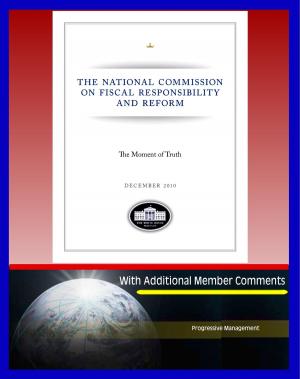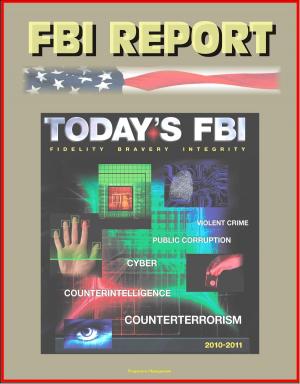Sowing the Seeds of Soft Power: The United States and India in the Next Great Game - Eurasia, Indian Domestic Values and Culture, Hollywood to Bollywood, Fight Against Terrorism, Nuclear Weapons
Nonfiction, History, Asian, India, Military, United States| Author: | Progressive Management | ISBN: | 9781370602377 |
| Publisher: | Progressive Management | Publication: | December 19, 2016 |
| Imprint: | Smashwords Edition | Language: | English |
| Author: | Progressive Management |
| ISBN: | 9781370602377 |
| Publisher: | Progressive Management |
| Publication: | December 19, 2016 |
| Imprint: | Smashwords Edition |
| Language: | English |
This excellent report has been professionally converted for accurate flowing-text e-book format reproduction. In both the 2010 and 2015 National Security Strategy, the White House published President Barack Obama's remarks emphasizing that the United States must integrate all the tools of national power to further U.S. strategic interests. This is especially true in a dynamic and increasingly multipolar world. In what this study calls the Next Great Game, the future key players in this emerging geopolitical scenario are Iran, Russia, China, and India. This study focuses on India. Using Joseph Nye's concept of hard power and soft power, this study explores what bonds can and do serve to align the United States and India. In doing so, this study makes it clear that the United States and India share several soft power bonds as a result of their respective historic connections to British colonialism, which to a certain degree has already set the conditions for the integration of all the tools of U.S. national power with India. Though historic disagreements and complex regional relations stymie the process, the United States must be cognizant of the type of relationship that is presenting itself and understand that the tools of government may be less important than the form of power being exercised.
While small-scale conflicts from the GWOT and post-GWOT era are sure to entangle U.S. hard power assets for the foreseeable future, it is imperative for the United States to remain engaged and shape the Next Great Game. To these ends, soft power provides a means for the United States to still continue to improve relations with a strong regional actor, like India. Furthermore, soft power is precisely the right application of U.S. national power given the geopolitical situation that is currently between the neighboring states in Eurasia. However, while this chapter has briefly addressed how U.S. soft power can improve relations with India, it has not addressed why U.S. soft power can work. With this concept at its focus, this study uncovers what are fundamental elements for the current soft power bonds that are between India and the United States. To do this, this study first explores what soft power is and what are the conditions that favor its cultivation. Next, this study uncovers some of the common bonds between India and the United States that have contributed to the favorable cultivation of U.S. soft power. Lastly, this study concludes with final thoughts and recommendations.
CHAPTER I - THE FUTURE OF GEOPOLITICS * A. THE NEXT GREAT GAME: EURASIA * B. THE NEXT GREAT GAME KEY PLAYERS: THE UNITED STATES AND INDIA * C. THE TOOLS AVAILABLE TO THE UNITED STATES IN THE NEXT GREAT GAME * CHAPTER II - U.S. SOFT POWER AND THE NEXT GREAT GAME * A. SOFT POWER, HARD POWER, AND SMART POWER * B. FINDING A RECEPTIVE AUDIENCE * CHAPTER III - THE SEEDS OF A U.S. SOFT POWER APPROACH TO INDIA * A. INDIAN DOMESTIC VALUES: A LEGACY OF THE BRITISH * 1. Common Language * 2. Concerns over Taxes and Representation * 3. The Role of Law * 4. Type of Government * 5. The Role of Government * B. INDIAN CULTURE: INFLUENCE FROM THE UNITED STATES * 1. Soft Power and the Ability to Export Culture * 2. From Hollywood to Bollywood * C. U.S. AND INDIAN FOREIGN POLICY: COMMON THEMES * 1. The Fight against Sponsored Terrorism * 2. The Use and Spread of Nuclear Weapons * CHAPTER IV - FINAL THOUGHTS AND RECOMMENDATIONS ABOUT U.S. SOFT POWER * A. U.S. SOFT POWER AND PAKISTAN * B. INDIAN SOFT POWER AND AFGHANISTAN * C. INDIA AND CHINA * D. CONCLUSION
This excellent report has been professionally converted for accurate flowing-text e-book format reproduction. In both the 2010 and 2015 National Security Strategy, the White House published President Barack Obama's remarks emphasizing that the United States must integrate all the tools of national power to further U.S. strategic interests. This is especially true in a dynamic and increasingly multipolar world. In what this study calls the Next Great Game, the future key players in this emerging geopolitical scenario are Iran, Russia, China, and India. This study focuses on India. Using Joseph Nye's concept of hard power and soft power, this study explores what bonds can and do serve to align the United States and India. In doing so, this study makes it clear that the United States and India share several soft power bonds as a result of their respective historic connections to British colonialism, which to a certain degree has already set the conditions for the integration of all the tools of U.S. national power with India. Though historic disagreements and complex regional relations stymie the process, the United States must be cognizant of the type of relationship that is presenting itself and understand that the tools of government may be less important than the form of power being exercised.
While small-scale conflicts from the GWOT and post-GWOT era are sure to entangle U.S. hard power assets for the foreseeable future, it is imperative for the United States to remain engaged and shape the Next Great Game. To these ends, soft power provides a means for the United States to still continue to improve relations with a strong regional actor, like India. Furthermore, soft power is precisely the right application of U.S. national power given the geopolitical situation that is currently between the neighboring states in Eurasia. However, while this chapter has briefly addressed how U.S. soft power can improve relations with India, it has not addressed why U.S. soft power can work. With this concept at its focus, this study uncovers what are fundamental elements for the current soft power bonds that are between India and the United States. To do this, this study first explores what soft power is and what are the conditions that favor its cultivation. Next, this study uncovers some of the common bonds between India and the United States that have contributed to the favorable cultivation of U.S. soft power. Lastly, this study concludes with final thoughts and recommendations.
CHAPTER I - THE FUTURE OF GEOPOLITICS * A. THE NEXT GREAT GAME: EURASIA * B. THE NEXT GREAT GAME KEY PLAYERS: THE UNITED STATES AND INDIA * C. THE TOOLS AVAILABLE TO THE UNITED STATES IN THE NEXT GREAT GAME * CHAPTER II - U.S. SOFT POWER AND THE NEXT GREAT GAME * A. SOFT POWER, HARD POWER, AND SMART POWER * B. FINDING A RECEPTIVE AUDIENCE * CHAPTER III - THE SEEDS OF A U.S. SOFT POWER APPROACH TO INDIA * A. INDIAN DOMESTIC VALUES: A LEGACY OF THE BRITISH * 1. Common Language * 2. Concerns over Taxes and Representation * 3. The Role of Law * 4. Type of Government * 5. The Role of Government * B. INDIAN CULTURE: INFLUENCE FROM THE UNITED STATES * 1. Soft Power and the Ability to Export Culture * 2. From Hollywood to Bollywood * C. U.S. AND INDIAN FOREIGN POLICY: COMMON THEMES * 1. The Fight against Sponsored Terrorism * 2. The Use and Spread of Nuclear Weapons * CHAPTER IV - FINAL THOUGHTS AND RECOMMENDATIONS ABOUT U.S. SOFT POWER * A. U.S. SOFT POWER AND PAKISTAN * B. INDIAN SOFT POWER AND AFGHANISTAN * C. INDIA AND CHINA * D. CONCLUSION















